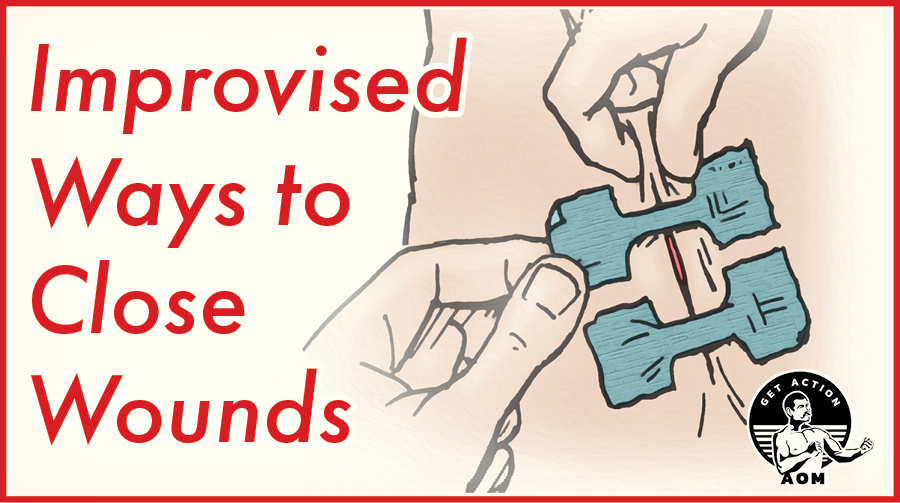
If you cut yourself and it opens a significant wound, you need to get it closed ASAP to avoid infection and allow it to heal properly.
To treat this kind of wound in ordinary times, you’d simply go to the doctor and they’d stitch you up.
But what if you’ve got an open wound in a dire emergency — a survival-type situation where it’s not possible to have medical professionals tend to the injury, either immediately, or ever?
Well, if you’ve got the skill and the grit, one option is to stitch it up yourself; we offer a tutorial on DIY suturing here. Suturing is certainly sturdy, and can effectively bring not only the top tissues of a wound together, but the tissues beneath as well — helpful if you’re dealing with a particularly deep and gaping wound.
But suturing has its downsides: it takes skill to do it right, it’s obviously quite painful without an anesthetic, and it’s invasive — by puncturing the skin with your needle, you’re running the risk of introducing bacteria into the body.
So before you sew yourself shut, try a couple of improvised wound-closing methods first: 1) duct tape butterfly bandages, and 2) superglue.
Closing a Wound Yourself Should Be a Last Resort
First, a big important caveat: closing a gaping wound yourself should be a last resort.
Your first-line approach to treating a gaping wound is to stop bleeding and keep the wound clean and covered so you can get a medical professional to close it up. Closing a wound improperly can at best create a wicked-looking scar, and at worst lead to a life-threatening infection.
You want to close a wound within 6-8 hours after the injury (you might be able to go 12-24 if the cut was made with something like a clean kitchen knife); after that, infection can set in.
So if you can make it to the doctor within that window of time, wait to have a medical professional take care of your injury. If it’s an emergency and it’s going to be a longer time before you can see a doctor, then consider closing it yourself with one of the below methods.
Butterfly Bandage From Duct Tape
Butterfly bandages should be the first thing you try when closing a wound. They’re easy to use, and can be easily removed to re-clean the wound if needed.
Every first aid kit should have some butterfly bandages in it, but if you ever find yourself without some, you can jerry-rig them out of duct tape. (Duct tape is easy to carry in your EDC and can come in handy for all kinds of things.) Here’s how to do it:
Cut a strip of duct tape 1 to 1 ½ inches long by ½ inch wide. Make four small cuts to create two tabs in the duct tape. The tabs should be about half an inch long.
Fold one tab in so that the two sticky sides stick together. Fold the other tab over the first tab. This will create a non-adhesive strip in your butterfly bandage.
Clean the wound.
Stick one end of the butterfly bandage to one side of the wound, pinch the wound together, pull the bandage across the cut, and then stick the other end on the other side of the wound. For large wounds, you may need to use multiple butterfly bandages.
Superglue
If for some reason you don’t have duct tape to make butterfly bandages, or the bandages aren’t keeping the wound shut, superglue can be used in a pinch.
Doctors actually use a product similar to superglue to close wounds. Medical glue, however, uses chemicals that are less toxic and more flexible. You can buy medical glue on Amazon.
Most people don’t have medical glue on hand in an emergency, however, while they often do have superglue.
Supergluing a wound shut should definitely be a method of last resort. When you glue a wound shut, you’re sealing in whatever contamination might be in the wound, which increases the chances of infection. If it does become infected, reopening a wound that’s been closed with superglue is difficult (and painful!), making re-cleaning the wound harder than it needs to be. 
With those caveats, here’s how to superglue a wound in a pinch:
Clean wound and dry surrounding skin.
Bring the sides of the wound together, making sure the edges are lined up as straight as possible. Apply a layer of superglue over the wound. Avoid letting the superglue get into the wound itself. Use as little as necessary to get the job done.
Continue holding the wound together for one minute so the glue can dry and cure.
The superglue will naturally fade away in about 10 days.




